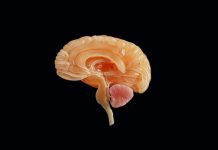
Alzheimer’s disease can feel like a treacherous journey. In the early stages, sticky plaques made of amyloid-beta proteins lead the way.
But as the disease progresses, tau tangles take the reins, triggering cognitive decline and dementia.
The problem has been that tracking the course of the disease has been tough. Up until now, there’s been no easy way to measure tau tangles in the brain.
A New Guidepost for Alzheimer’s Disease
Scientists from Washington University School of Medicine in St. Louis and Lund University in Lund, Sweden have found a potential game-changer: a specific type of tau that could help track Alzheimer’s progression.
The team studied 667 people from Sweden and the U.S. at different stages of Alzheimer’s disease.
They found that levels of this tau form, called MTBR-tau243, in the cerebrospinal fluid matched the amount of harmful tau tangles in the brain and the degree of cognitive decline.
This finding could be a massive step towards better diagnosing and staging Alzheimer’s disease.
A test based on MTBR-tau243 could speed up drug development by providing an inexpensive way to identify and monitor participants in clinical trials and see if the experimental therapies are altering the course of the disease.
“We’ve now got biomarkers to specifically track the progression of tau tangles, the major factor in dementia and cognitive decline,” said co-senior author Randall J. Bateman, MD.
“These findings will help accelerate drug development for Alzheimer’s patients and improve patient care.”
The Hurdles of Current Methods
The current “gold standard” for measuring tau tangles in the brain is the tau-positron emission tomography (tau-PET) brain scan.
But these scans are expensive, require specialized equipment and expertise, and are not widely available, making them impractical for patient care and costly for research studies.
The Potential of MTBR-tau243
In 2020, Bateman and Kanta Horie, Ph.D., showed that MTBR-tau243 levels in the cerebrospinal fluid reflected the amount of tau tangles in the brain.
In this new study, they expanded their analysis to a larger group and compared MTBR-tau243 to other tau biomarkers.
They found that MTBR-tau243 levels in the cerebrospinal fluid strongly correlated with tau tangle levels in the brain and cognitive function.
In contrast, another form of tau, phosphorylated tau, mainly tracked with brain amyloid levels but not with tau levels or cognitive function.
A Beacon of Hope
The discovery of this new biomarker could improve the diagnostic and prognostic work-up of Alzheimer’s disease globally.
“With this new biomarker, we can diagnose Alzheimer’s using a single cerebrospinal fluid sample,” says co-senior author Oskar Hansson, MD, Ph.D. He also hopes to accomplish this using a simple blood test soon.
By combining the two forms of tau in the cerebrospinal fluid—phosphorylated tau and MTBR-tau243—the researchers could predict cognitive function almost as well as with tau-PET scans.
This could be a game-changer for Alzheimer’s research.
By taking repeated samples of cerebrospinal fluid, researchers can track the disease’s progression and the effect of interventions like experimental anti-tau therapeutics.
“In late stages of Alzheimer’s, anti-amyloid therapies may not work as well because amyloid is no longer a major player in the disease,” Horie said.
“But that’s when tau becomes relevant. By stopping the tau pathology, we may be able to prevent further cognitive decline and help people maintain a good quality of life. That’s what we’re working toward.”
The study was published in Nature Medicine.
Follow us on Twitter for more articles about this topic.
Copyright © 2023 Knowridge Science Report. All rights reserved.



